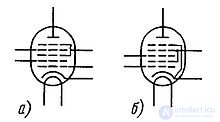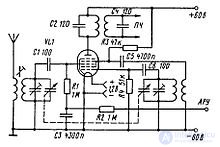Lecture
Heptode (Pentagrid) is an electron tube with seven electrodes: a cathode, an anode and five grids. The main purpose is a frequency converter in a superheterodyne radio receiver.
According to international practice, any lamp with seven electrodes can be referred to as heptod. In fact, under this name there are two classes of lamps.
One of them is a completely independent converter, it contains a local oscillator and a mixer in one electrode structure, it has the second name “pentahydride” (translated as “five-grid lamp”). In the Soviet lamp nomenclature, the most typical example is the 6A8 lamp.
The second type of heptod is designed to use a separate local oscillator, for which later triode-heptho combined lamps began to be produced in the USSR 6I1P, 6I3P.
The appearance of heptod was preceded by the invention, which radically altered the whole technique of radio reception, the principle of superheterodyne reception.
The conversion of a signal of any received frequency into a certain constant signal of an intermediate frequency sharply increased (as compared with direct amplification receivers) selectivity and sensitivity - the main quality indicators of any receiver. Simultaneously with the transition to a superheterodyne receiver, the need for special dual-frequency frequency converter lamps was needed.
The conversion of the received frequency signal into the intermediate frequency signal can be carried out in two ways: according to the combined scheme and according to a separate heterodyne.
When combined, the functions of the local oscillator and the mixer could be performed by one special five-grid lamp in which the local oscillator and the mixer were switched on sequentially, that is, the two grids closest to the cathode formed a heterodyne triode, and the following grids were part of the input amplifier. The confusion of these two signals occurred due to the fact that the anode current of both lamps was common.
In the circuit with a separate heterodyne, the voltage of the auxiliary frequency was generated by a special cascade on a triode or pentode, and the signals were mixed in another double-controlled lamp (pentode or hexode). Initially, preference was given to the first option as more economical (one lamp instead of two). To implement it, a special five-grid lamp - pentagrid was developed.

The number of grids in both lamps is the same, but it is not difficult to see that their purpose is different. The first, closest to the cathode grid in both lamps is the controlling part of the generating triode - the local oscillator. At pentagrid, the second grid performs the function of the anode of the same triode, while the heptode does not have this grid.
The next step was the appearance of two shielding grids instead of one. This was due to the fact that the tetrodes and pentodes had only one control grid, which was fenced off from the anode by the screen grid.
In the new lamp - the pentagrid - it has been preserved: it is the “lower” of the two screen grids. But then the second control grid turned out to be near the anode, that is, it turned the mixing part of the lamp into an ordinary triode with its main disadvantage inherent — the large anode throughput of the anode — the grid. To eliminate it, an additional, second screen grid connected inside the lamp with the first screen grid was placed between the second control grid and the anode, since both of them performed the same function.
And everything would be great, but in such a pentagrid there was no antidynamic grid left. And then heptodes replaced the pentagride, in which the antidinatron grid was “restored” by eliminating the grid, which served as the anode of the heterodyne triode in the pentagride. And the joint screen grid began to play its role.

Unlike conventional circuits, where the screen grid is “grounded” at high frequency by a capacitor of sufficiently large capacity, in this case, the heterodyne loop feedback coil (in the positive phase) is switched on to supply the screen grids to provide self-excitation of the heterodyne.
Both pentagrids and heptodes lived a long life, performing the functions of frequency conversion lamps. The first domestic Pentagrid of the type SO-183 was released back in the 1930s, and 6A2P type heptods were used in broadcast receivers until the 1970s.
It is necessary to note the presence of additional parameters in five-grid lamps, which all types of lamps of less complexity did not have. First of all, this is the slope of the conversion S pr - is the ratio of the variable component of the anode current of intermediate frequency I a pch to the alternating voltage of the RF signal on the second control (signal) grid U signal. In other words, the steepness of the transformation shows what amplitude of the intermediate frequency current creates a signal voltage, with an amplitude of 1 V at a given alternating voltage on the heterodyne grid.
Another specific difference of five-grid lamps from triodes, tetrodes, and pentodes is that two graphic characteristics, anode and grid ones, are not enough to evaluate their properties. This is because the usual anode characteristic as a function of the voltage on one of the control grids varies greatly, not only depending on the voltage on the screen grid, but also on the voltage on the second control grid. Therefore, five-grid lamps, as a rule, are accompanied by at least four families of graphic characteristics.
Comments
To leave a comment
Radio tubes and ion devices
Terms: Radio tubes and ion devices